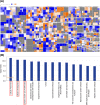Eukaryotic initiation factor 3, subunit C silencing inhibits cell proliferation and promotes apoptosis in human ovarian cancer cells
- PMID: 31316002
- PMCID: PMC6685053
- DOI: 10.1042/BSR20191124
Eukaryotic initiation factor 3, subunit C silencing inhibits cell proliferation and promotes apoptosis in human ovarian cancer cells
Abstract
Ovarian cancer remains the leading cause of death among all gynaecological cancers, illustrating the urgent need to understand the molecular mechanisms involved in this disease. Eukaryotic initiation factor 3c (EIF3c) plays an important role in protein translation and cancer cell growth and proliferation, but its role in human ovarian cancer is unclear. Our results showed that EIF3c silencing significantly up-regulated 217 and down-regulated 340 genes. Ingenuity Pathway Analysis (IPA) indicated that the top differentially expressed genes are involved in 'Classical Pathways', 'Diseases and Functions' and 'Networks', especially those involved in signalling and cellular growth and proliferation. In addition, eIF3c silencing inhibited cellular proliferation, enhanced apoptosis and regulated the expression of apoptosis-associated proteins. In conclusion, these results indicate that by dysregulating translational initiation, eIF3c plays an important role in the proliferation and survival of human ovarian cancer cells. These results should provide experimental directions for further in-depth studies on important human ovarian cancer cell pathways.
Keywords: IPA; apoptosis; eIF3c; ovarian cancer cells,; proliferation.
© 2019 The Author(s).
Conflict of interest statement
The authors declare that there are no competing interests associated with the manuscript.
Figures





Similar articles
-
Eukaryotic initiation factor 3C silencing inhibits cell proliferation and promotes apoptosis in human glioma.Oncol Rep. 2015 Jun;33(6):2954-62. doi: 10.3892/or.2015.3881. Epub 2015 Mar 30. Oncol Rep. 2015. PMID: 25823503
-
Upregulated expression of eIF3C is associated with malignant behavior in renal cell carcinoma.Int J Oncol. 2019 Dec;55(6):1385-1395. doi: 10.3892/ijo.2019.4903. Epub 2019 Oct 21. Int J Oncol. 2019. PMID: 31638200
-
Decreasing Eukaryotic Initiation Factor 3C (EIF3C) Suppresses Proliferation and Stimulates Apoptosis in Breast Cancer Cell Lines Through Mammalian Target of Rapamycin (mTOR) Pathway.Med Sci Monit. 2017 Aug 30;23:4182-4191. doi: 10.12659/msm.906389. Med Sci Monit. 2017. PMID: 28854163 Free PMC article.
-
The m6A reader YTHDF1 promotes ovarian cancer progression via augmenting EIF3C translation.Nucleic Acids Res. 2020 Apr 17;48(7):3816-3831. doi: 10.1093/nar/gkaa048. Nucleic Acids Res. 2020. PMID: 31996915 Free PMC article.
-
Transcriptomic analyses of RNA-binding proteins reveal eIF3c promotes cell proliferation in hepatocellular carcinoma.Cancer Sci. 2017 May;108(5):877-885. doi: 10.1111/cas.13209. Epub 2017 Apr 26. Cancer Sci. 2017. PMID: 28231410 Free PMC article.
Cited by
-
Tilianin inhibits the human ovarian cancer (PA-1) cell proliferation via blocking cell cycle, inducing apoptosis and inhibiting JAK2/STAT3 signaling pathway.Saudi J Biol Sci. 2021 Sep;28(9):4900-4907. doi: 10.1016/j.sjbs.2021.06.033. Epub 2021 Jun 24. Saudi J Biol Sci. 2021. PMID: 34466064 Free PMC article.
-
ZNF280A promotes lung adenocarcinoma development by regulating the expression of EIF3C.Cell Death Dis. 2021 Jan 4;12(1):39. doi: 10.1038/s41419-020-03309-9. Cell Death Dis. 2021. PMID: 33414445 Free PMC article.
-
N6-Methyladenosine Methylation of mRNA in Cell Apoptosis.Mol Neurobiol. 2024 Jul;61(7):3934-3948. doi: 10.1007/s12035-023-03813-x. Epub 2023 Dec 2. Mol Neurobiol. 2024. PMID: 38040996 Review.
-
Hypoxia-Induced Adaptations of miRNomes and Proteomes in Melanoma Cells and Their Secreted Extracellular Vesicles.Cancers (Basel). 2020 Mar 14;12(3):692. doi: 10.3390/cancers12030692. Cancers (Basel). 2020. PMID: 32183388 Free PMC article.
-
Knockdown EIF3C Suppresses Cell Proliferation and Increases Apoptosis in Pancreatic Cancer Cell.Dose Response. 2020 Sep 10;18(3):1559325820950061. doi: 10.1177/1559325820950061. eCollection 2020 Jul-Sep. Dose Response. 2020. Retraction in: Dose Response. 2024 Oct 18;22(4):15593258241282445. doi: 10.1177/15593258241282445. PMID: 32973416 Free PMC article. Retracted.
References
Publication types
MeSH terms
Substances
LinkOut - more resources
Full Text Sources
Medical

